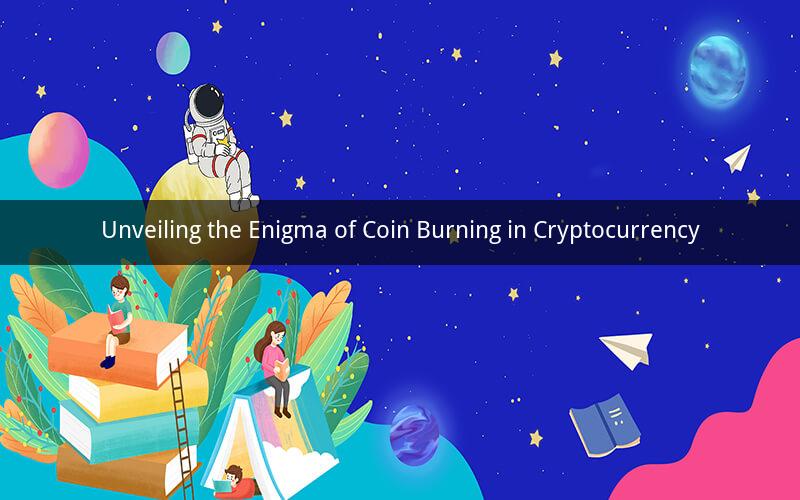
In the vast world of cryptocurrencies, there exists a phenomenon known as coin burning. This process has gained significant attention in recent years, and many individuals are eager to understand its purpose and implications. This article delves into the intricacies of coin burning, exploring its definition, significance, and potential effects on the cryptocurrency market.
1. What is Coin Burning?
Coin burning refers to the process of permanently removing a certain amount of cryptocurrency from circulation. It involves destroying the coins, rendering them unusable and effectively reducing the total supply of the currency. The primary objective of coin burning is to decrease the inflation rate and increase the scarcity of the digital asset.
2. The Significance of Coin Burning
The significance of coin burning can be understood from various perspectives:
a. Price Stability: By reducing the supply of a cryptocurrency, coin burning aims to stabilize its price. As the demand for the currency remains constant, a decrease in supply can lead to an increase in price, thus reducing the volatility associated with many cryptocurrencies.
b. Scarcity: Scarcity is a fundamental concept in economics, and coin burning contributes to it. By eliminating coins from circulation, the scarcity of the currency increases, which can potentially lead to higher demand and, consequently, a higher market value.
c. Incentivizing HODLers: HODLers, individuals who hold onto their cryptocurrencies rather than selling them, benefit from coin burning. As the supply decreases, the value of their holdings may increase, incentivizing them to maintain their positions.
3. The Process of Coin Burning
The process of coin burning varies depending on the cryptocurrency. However, the general steps involved are as follows:
a. Detection: The cryptocurrency community or developers identify a specific amount of coins to be burned. This could be a predetermined percentage of the total supply or a specific number of coins.
b. Agreement: The decision to burn coins is typically agreed upon by a consensus within the community or by the developers of the cryptocurrency.
c. Execution: The coins are transferred to a "burn address," which is a special address designed to destroy the coins. Once the coins are sent to this address, they become inaccessible and are considered burned.
d. Verification: The community or developers verify that the coins have been successfully burned by checking the blockchain.
4. Potential Effects of Coin Burning
While coin burning has several potential benefits, it is not without its drawbacks:
a. Reduced Supply: As mentioned earlier, coin burning decreases the total supply of a cryptocurrency. This can lead to higher prices, which may be beneficial for HODLers but could deter new investors.
b. Market Manipulation: In some cases, coin burning may be used as a means of market manipulation. Developers or influential members of the community could potentially manipulate the supply to benefit their own interests.
c. Lack of Transparency: The process of coin burning can sometimes be lackluster in terms of transparency. Without clear guidelines and regulations, it may be difficult to determine the authenticity of a coin burning event.
5. Frequently Asked Questions about Coin Burning
a. Question: How does coin burning differ from a regular cryptocurrency transaction?
Answer: Coin burning involves transferring coins to a burn address, which effectively renders them unusable. In contrast, a regular cryptocurrency transaction involves transferring coins from one address to another, which is a standard process on the blockchain.
b. Question: Can coin burning be reversed?
Answer: No, once coins are burned, they cannot be reversed. This is because the burn address is designed to destroy the coins, making them inaccessible.
c. Question: Is coin burning legal?
Answer: The legality of coin burning varies depending on the jurisdiction. In some countries, it may be subject to regulations, while in others, it may be completely legal.
d. Question: Can all cryptocurrencies implement coin burning?
Answer: No, not all cryptocurrencies can implement coin burning. It requires specific protocols and consensus within the community or among developers.
e. Question: Is coin burning a guaranteed way to increase the value of a cryptocurrency?
Answer: While coin burning can potentially increase the value of a cryptocurrency, it is not a guaranteed outcome. Other factors, such as market demand, competition, and overall economic conditions, also play a significant role in determining the value of a cryptocurrency.
In conclusion, coin burning is a fascinating aspect of the cryptocurrency world. While it has the potential to stabilize prices, increase scarcity, and incentivize HODLers, it also comes with its own set of risks and challenges. Understanding the process and its implications is crucial for anyone interested in cryptocurrencies.